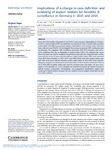Implications of a change in case definition and screening of asylum seekers for hepatitis B surveillance in Germany in 2015 and 2016
von Laer, Anja
Diercke, Michaela
an der Heiden, Matthias
Altmann, Doris
Zimmermann, Ruth
Dudareva, Sandra
Since 2015, the number of hepatitis B virus (HBV) cases increased substantially in Germany. In 2015, a more sensitive HBV case definition was introduced. This coincided with an asylum seeker influx with differing screening strategies. Information on the asylum seeker status has been collected since 09/2015. We investigated this increase to interpret HBV notification data in Germany. We compared HBV surveillance data from 2010–2013 (baseline) with 2015–2016, excluding 2014 due to beginning of asylum seeker influx. We estimated the excess above the mean case number (baseline) using Poisson regression and compared asylum seeker cases and the excess of cases with the unknown asylum seeker status. HBV cases increased from 1855 (mean baseline) to 3873 (2015) and 3466 (2016) with 1903 asylum seeker cases and 1099 excess-cases with the unknown asylum seeker status in 2015–2016. Cases only fulfilling the changed case definition increased from 60% (1119) in baseline to 81% (P < 0.01) in 2015–2016; 69% of asylum seeker cases and 61% of excess-cases were males <40 years compared to 27% (baseline) (P < 0.01). Changed case definition increased the number of cases in official statistics substantially. Demographic and geographical distributions suggest that screening of asylum seekers increased the case numbers even to a higher extent than surveillance data indicates.
Dateien zu dieser Publikation

